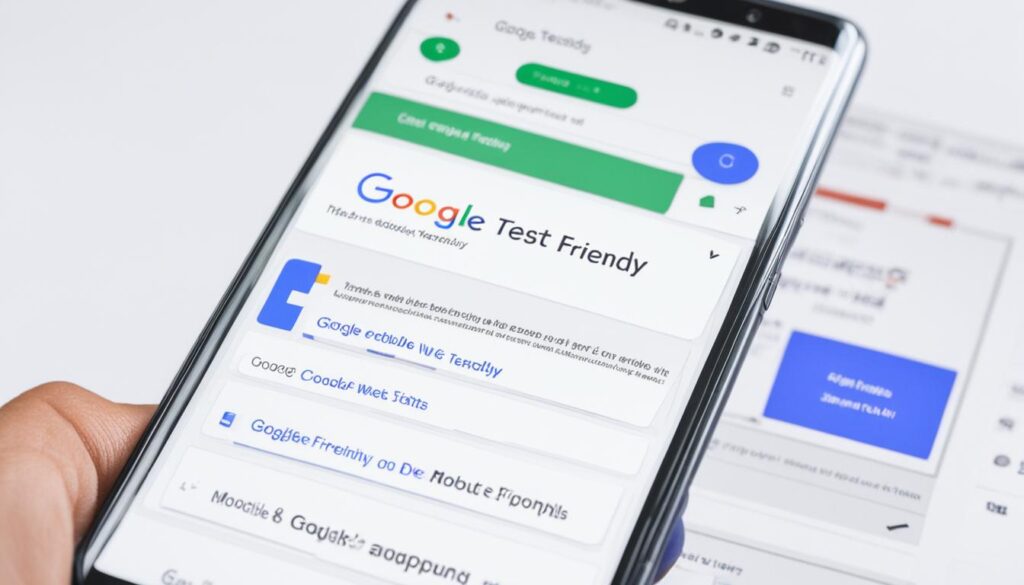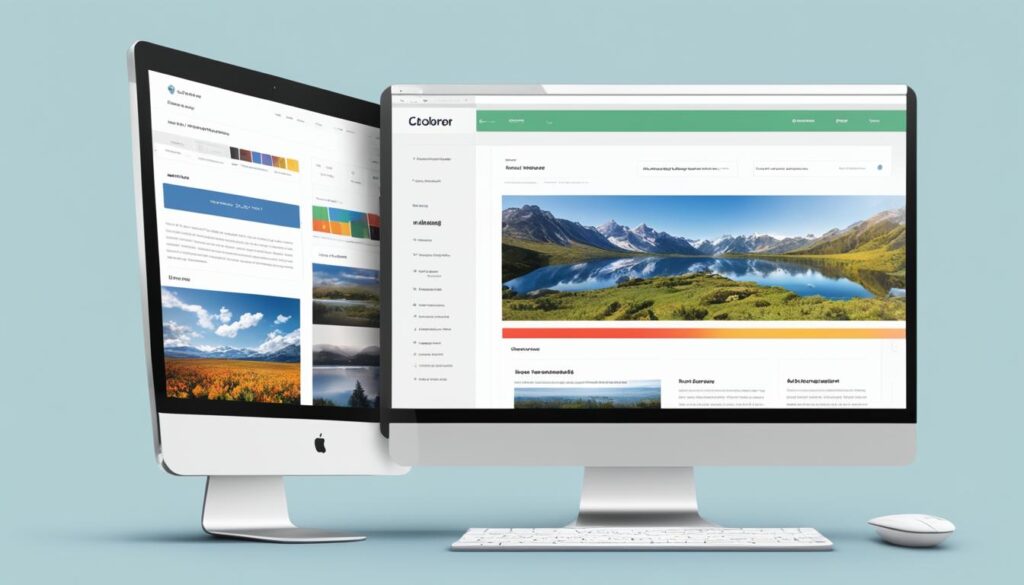In today’s fast-paced world, having a mobile-friendly website is crucial for the success of any business. With a majority of internet traffic coming from mobile devices, it’s important to optimize your website for mobile users. A mobile-friendly website not only enhances user experience but also helps you reach a larger audience and stay ahead of the competition. At WebsiteDesigner.Business, we understand the importance of mobile optimization and offer expert solutions to help your business thrive in the digital landscape.
When it comes to web design for mobile, there are several key elements to consider. By adopting a mobile-first approach, you can ensure that your website is specifically designed and developed for mobile devices. This approach prioritizes the mobile experience, resulting in a seamless and user-friendly interface for your mobile users. Correctly sizing text and photos, implementing a search function, and incorporating fully responsive web design are also essential for creating a mobile-friendly website.
Accounting for different screen sizes, delivering immediate answers, ensuring compatibility with major devices, optimizing page loading speeds, and simplifying design are additional factors that contribute to a successful mobile website. By considering these elements, you can create a mobile optimized website that provides a clear and streamlined experience for your users, resulting in increased engagement and conversions.
Key Takeaways:
- Having a mobile-friendly website is crucial for the success of any business.
- A mobile-first approach and fully responsive web design are key elements to consider.
- Optimizing page loading speeds and simplifying design contribute to better user experience.
- Accounting for different screen sizes and compatibility with major devices are important for a seamless mobile experience.
- A mobile-friendly website leads to increased engagement and conversions.
The Importance of Mobile Optimization
In today’s digital landscape, having a mobile-friendly website is no longer a luxury but a necessity. With the majority of web traffic coming from mobile devices, optimizing your website for mobile users is crucial for reaching a larger audience and staying competitive. Mobile optimization ensures that your website provides a seamless and enjoyable experience for mobile users, improving user experience and increasing engagement. It is also important for search engine optimization (SEO), as Google ranks mobile-friendly websites higher in search results.
Mobile optimization goes beyond simply resizing your website to fit different screen sizes. It involves creating a mobile-friendly design that is intuitive, fast, and compatible with various devices and operating systems. By prioritizing mobile optimization, you can capture the attention of mobile users and provide them with a positive browsing experience, ultimately leading to higher conversions and customer satisfaction.
The Benefits of Mobile Optimization
- Improved User Experience: Mobile-optimized websites are designed to be user-friendly and easily navigable on smaller screens. They have streamlined layouts, legible fonts, and touch-friendly buttons, making it easier for users to find and consume content.
- Increased Mobile Traffic: With the majority of internet users accessing websites through mobile devices, optimizing your site for mobile can significantly increase your reach and traffic. A mobile-friendly website ensures that your content is accessible and engaging to mobile users, driving more organic traffic to your site.
- Higher Customer Engagement: A mobile-optimized website provides a seamless and enjoyable user experience, encouraging visitors to stay longer on your site and engage with your content. This can lead to increased page views, lower bounce rates, and higher conversion rates.
- Improved SEO Performance: Google prioritizes mobile-friendly websites in its search engine rankings. By optimizing your site for mobile, you increase your chances of appearing higher in search results, driving more organic traffic to your site.
- Competitive Advantage: As more businesses invest in mobile optimization, having a mobile-friendly website sets you apart from competitors. It shows that you value user experience and adapt to the changing digital landscape, giving you a competitive edge.
By prioritizing mobile optimization, you can enhance the overall performance of your website and cater to the needs of your mobile audience. Not only will this result in higher engagement and conversions, but it will also future-proof your online presence as mobile usage continues to grow.

| Mobile Optimization Strategies | Benefits |
|---|---|
| Responsive Web Design | Adapts your website layout to different screen sizes, ensuring a consistent and user-friendly experience across devices. |
| Fast Page Load Speed | Reduces bounce rates and improves user experience by optimizing your site’s performance and loading speed. |
| Optimized Images | Minimizes bandwidth usage and improves load times by compressing and resizing images for mobile devices. |
| Minimized HTTP Requests | Reduces load times by minimizing the number of requests made to the server, optimizing website performance. |
| Mobile-Friendly Navigation | Improves user experience by simplifying navigation and ensuring easy access to important information on mobile devices. |
Statistics on Mobile Internet Usage
Mobile devices have revolutionized the way we connect and interact with the world. With billions of people worldwide relying on smartphones, the impact of mobile internet usage cannot be ignored. This section highlights some eye-opening statistics that emphasize the significance of mobile optimization for businesses.
According to recent data:
- Mobile devices account for more than half of global web traffic. As people increasingly rely on their smartphones and tablets to access the internet, it becomes crucial for businesses to cater to mobile users to reach a wider audience.
- On average, individuals spend approximately 3 hours and 15 minutes per day on their mobile devices. As mobile devices become an integral part of our lives, businesses must ensure their websites are mobile-friendly to accommodate this growing trend.
- Mobile searches often lead to online action within an hour. Mobile users are highly engaged and ready to take action, making it essential for brands to provide a seamless mobile experience to capture these opportunities.
- Mobile ecommerce sales continue to rise steadily. In fact, mobile ecommerce sales are expected to reach $3.56 trillion by 2021. This presents a massive opportunity for businesses that optimize their websites for mobile, allowing them to tap into the growing mobile commerce market.
These statistics demonstrate the undeniable impact of mobile devices on internet usage and consumer behavior. To remain competitive in today’s digital landscape, businesses must prioritize mobile optimization to meet the expectations of mobile users and capitalize on the growing mobile traffic and commerce.
Take a look at the table below for a visual representation of these statistics:
| Mobile Internet Usage | Statistics |
|---|---|
| Global web traffic from mobile devices | More than half |
| Average daily time spent on mobile devices | 3 hours and 15 minutes |
| Time to online action after mobile searches | Within an hour |
| Mobile ecommerce sales expected by 2021 | $3.56 trillion |

Mobile Optimization Strategies
When it comes to mobile optimization, implementing responsive web design is crucial. Responsive web design allows your website to adapt seamlessly to different screen sizes and resolutions, ensuring a user-friendly experience on any device.
In order to achieve this, media queries can be utilized to customize the layout for various screen resolutions. By using media queries, you can optimize the design and ensure that your website looks great on both large desktop screens and smaller mobile screens.
However, having a visually appealing design is just one part of mobile optimization. Page load speed is another critical factor that can significantly impact user experience. Slow loading sites often result in high bounce rates, frustrating users and prompting them to leave your website.
To improve page load speed, it’s essential to optimize various elements, including images and HTTP requests. One effective strategy is image optimization, where you compress images to reduce their file size without compromising quality. This helps reduce the loading time and ensures faster page rendering on mobile devices.
Additionally, minimizing HTTP requests is equally important. Each request made by a mobile device adds overhead and slows down the loading process. By minimizing HTTP requests, you can enhance page load speed and improve overall performance.
Remember, a fast-loading website leads to better user experience, increased engagement, and improved search engine rankings. So take the time to optimize your images and minimize unnecessary requests.
Another aspect of mobile optimization is enhancing user experience. Simplifying the navigation, avoiding pop-ups, and utilizing a large and readable font can greatly improve the overall user experience on mobile devices.
Now, let’s take a look at some of the key aspects of mobile optimization strategies:
- Implement responsive web design
- Utilize media queries to customize layout
- Optimize page load speed
- Compress images for faster loading
- Minimize HTTP requests
- Simplify navigation and avoid pop-ups
- Use a large and readable font
By following these mobile optimization strategies, you can ensure that your website delivers a seamless user experience, improves page load speed, and keeps users engaged on their mobile devices.

Testing and Monitoring Mobile Performance
Regularly testing and monitoring your website’s mobile performance is crucial to ensure it remains mobile-friendly. By utilizing mobile-friendly testing tools and conducting thorough evaluations, you can identify potential issues and make necessary improvements to enhance the mobile user experience.
One of the most popular mobile-friendly testing tools is Google’s Mobile-Friendly Test. This tool analyzes your website’s responsiveness and provides valuable insights and suggestions for improvement. It evaluates various factors that contribute to mobile performance, such as page loading speed, font sizing, and touch targets.
When testing your website’s mobile performance, it is essential to consider different devices and platforms. Test your website on both Android and iOS devices to ensure a seamless user experience across platforms. This will help you identify any compatibility issues and optimize your website’s functionality regardless of the device being used.
Regular testing is necessary, especially after making any updates or changes to your website. It allows you to detect and rectify any potential mobile performance issues promptly. By continuously monitoring and optimizing your mobile performance, you can ensure that your website remains mobile-friendly and provides an exceptional user experience.
“Regularly testing and monitoring your website’s mobile performance guarantees that your site remains user-friendly and accessible to mobile users. It allows you to identify and address any issues that may hinder the mobile experience, ultimately improving user satisfaction and engagement.” – SEO Expert
Mobile Performance Evaluation Checklist:
- Test your website’s responsiveness using Google’s Mobile-Friendly Test.
- Ensure your website functions seamlessly on both Android and iOS devices.
- Monitor your website’s loading speed and make necessary optimizations.
- Check if fonts and touch targets are appropriately sized for mobile users.
- Verify that all functionalities, such as forms and navigation, work smoothly on mobile devices.
Google’s Mobile-Friendly Test Example:

| Website | Mobile-Friendly | Page Loading Speed |
|---|---|---|
| Website A | Yes | 4.2 seconds |
| Website B | No | 8.9 seconds |
| Website C | Yes | 2.5 seconds |
Table: Example of Mobile Performance Evaluation
Understanding the Importance of Mobile Optimization
In today’s digital landscape, building a mobile-friendly website is no longer a luxury but a necessity. With more than 50% of web traffic coming from mobile devices, optimizing your website for mobile users is crucial for reaching a larger audience and staying competitive in your industry. Ignoring mobile optimization can result in frustrated users, high bounce rates, and missed conversions.
“Building a mobile-friendly website is no longer a luxury but a necessity in today’s digital landscape.”
Mobile optimization offers several key benefits that can significantly impact your online success. Firstly, it improves user experience by providing a seamless and enjoyable browsing experience on mobile devices. Mobile-friendly websites ensure that your content is easily accessible, readable, and navigable on smaller screens, maximizing user satisfaction. Positive user experiences lead to increased engagement, longer visit durations, and higher conversion rates.
Furthermore, mobile optimization provides a competitive advantage. By catering to the growing number of mobile users, you can differentiate your brand and attract a larger customer base. Mobile-friendly websites demonstrate that your business is forward-thinking, technologically proficient, and attentive to customer needs. This can help build trust and credibility among your target audience, giving you an edge over competitors who have not prioritized mobile optimization.
Additionally, mobile optimization plays a crucial role in driving website traffic. As search engines prioritize mobile-friendly websites in search results, having a mobile-optimized site increases your visibility and organic reach. With higher rankings, your website is more likely to receive clicks, resulting in increased organic traffic. This, in turn, can lead to more conversions, sales, and business growth.
In summary, mobile optimization is a vital aspect of web design and digital marketing. It improves user experience, provides a competitive advantage, and drives website traffic. With the majority of web users accessing the internet via mobile devices, neglecting mobile optimization can hinder your online success. By investing in mobile-friendly design and optimizing your website for mobile users, you can enhance user satisfaction, increase engagement, and achieve better business outcomes.
| Benefits of Mobile Optimization | |
|---|---|
| Improved user experience on mobile devices | Increased engagement and conversions |
| Competitive advantage | Differentiation and trust-building |
| Increased website traffic | Better search engine rankings and visibility |

Implementing Responsive Web Design
When it comes to creating a mobile-friendly website, responsive web design is an absolute must. It ensures that your site automatically adjusts to different screen sizes and resolutions, providing users with a seamless and enjoyable browsing experience. By implementing a mobile-responsive theme and utilizing CSS media queries, you can customize the layout, font sizes, and image sizes based on the user’s device.
Responsive web design plays a crucial role in enhancing user experience. It allows your website to adapt to the specific needs of mobile users, ensuring that content is easily accessible and visually appealing. With a responsive design, users won’t have to pinch and zoom or scroll horizontally to view your website, eliminating frustrations and maximizing engagement.
Using a mobile-responsive theme is a practical approach to incorporate responsive web design into your website. These themes are specifically designed to automatically adjust the layout and appearance based on the user’s device, eliminating the need for manual adjustments. This saves time and effort while guaranteeing a consistent and user-friendly experience across various screens.
CSS media queries are powerful tools for implementing responsive web design. These queries allow you to set different styles and layout rules based on the characteristics of the device being used. With media queries, you can easily adjust font sizes, hide or display specific content, and optimize image sizes, ensuring that your website looks great on any screen.
To illustrate the importance of responsive web design, consider the following example:
“Our website recently underwent a redesign to incorporate responsive web design. The results were outstanding. We saw a significant increase in user engagement and a decrease in bounce rates. With the use of a mobile-responsive theme and CSS media queries, our website seamlessly adapts to different devices, providing a consistent, visually appealing experience for our mobile users.”
– John Smith, CEO of XYZ Company

| Benefits of Responsive Web Design | Examples |
|---|---|
| Enhanced user experience | Smooth navigation and easy readability on all devices |
| Improved mobile search rankings | Higher visibility and organic traffic from mobile users |
| Consistent branding | Brand perception remains consistent across devices |
| Faster loading times | Optimized performance and reduced bounce rates |
| Increased conversion rates | Seamless user experience leads to higher conversions |
Implementing responsive web design is crucial for building a mobile-friendly website that delivers an exceptional user experience. By using a mobile-responsive theme, leveraging CSS media queries, and embracing a mobile-first approach, you can ensure that your website is accessible and visually appealing to mobile users, ultimately driving engagement and boosting your online success.
Optimizing Page Load Speed
Optimizing the speed at which your web pages load is crucial for mobile optimization. Slow loading sites not only frustrate visitors but also lead to high bounce rates, negatively impacting user experience and conversions. To ensure a seamless and enjoyable mobile experience, we recommend implementing the following strategies:
1. Compress and Optimize Images
Images are often the largest elements on a web page and can significantly impact load times. Compressing and optimizing images can greatly reduce file sizes without compromising image quality. By using tools such as image compression software, you can strike a balance between visual appeal and faster load times. Remember to always use alt tags to describe the image content for search engine optimization.
2. Minimize HTTP Requests
Each element on your web page requires a separate HTTP request, which adds to the overall load time. To minimize these requests, consider combining CSS and JavaScript files, reducing the number of external resources, and utilizing browser caching. This will reduce the server’s workload and significantly improve page load speed.
3. Utilize Lazy Loading Techniques
Lazy loading is a technique that only loads elements on a page as they become visible to the user. This helps prioritize the initial content load and enhances the perception of speed. By implementing lazy loading for images, videos, and other multimedia elements, you can dramatically improve the overall performance of your mobile website.
4. Use a Content Delivery Network (CDN)
A Content Delivery Network (CDN) is a network of servers distributed globally that delivers web content to users based on their geographic location. By storing cached versions of your website’s static files on servers closer to the user, a CDN can significantly reduce the distance and time it takes for content to travel. This results in improved page load speed, especially for mobile users accessing your website from different locations.
By prioritizing page load speed and implementing these strategies, you can create a mobile website that provides a seamless and enjoyable user experience. Visitors will stay engaged, increasing the likelihood of conversions and boosting the overall success of your online presence.

Reducing Image Sizes
When it comes to mobile optimization, reducing image sizes is crucial. Large images can significantly slow down page load speed and negatively impact user experience on mobile devices. We understand the importance of providing a seamless and fast browsing experience for your website visitors, especially those accessing your site on their smartphones or tablets.
To optimize image sizes without sacrificing quality, we recommend utilizing effective image compression techniques. By compressing your images, you can decrease their file sizes while maintaining visually pleasing and high-quality visuals. This helps to improve page load speed and ensures that your website loads quickly and efficiently on mobile devices.
In addition to image compression, you can also consider using modern image formats like WebP. WebP is a highly efficient image format developed by Google that offers superior compression rates without compromising visual quality. By converting your images to WebP format, you can further reduce file sizes and enhance mobile performance.
Furthermore, employing responsive image techniques is essential for delivering the appropriate image size to each device. Responsive image techniques involve using HTML and CSS to ensure that the optimal image resolution is displayed based on the user’s device and screen size. This not only helps to improve performance but also enhances the overall user experience on mobile devices.
| Benefits of Reducing Image Sizes for Mobile Optimization |
|---|
| Improved page load speed: Smaller image sizes result in faster loading times, reducing bounce rates and improving user experience. |
| Enhanced mobile performance: Optimized images help your website perform seamlessly on mobile devices, allowing users to browse and interact effortlessly. |
| Increased user satisfaction: Faster loading times and improved performance contribute to a positive user experience, leading to higher engagement and conversions. |

By implementing image optimization techniques such as compression, utilizing WebP format, and employing responsive image techniques, you can effectively reduce image sizes and create a mobile-friendly website that delivers an exceptional user experience. Don’t let large images slow down your website and frustrate mobile users. Take the necessary steps to optimize your website’s images for improved mobile performance today.
Minimizing HTTP Requests
When it comes to optimizing your website for mobile, minimizing HTTP requests is a vital consideration. Each request made by a mobile device adds overhead and affects the overall page load speed. As website performance plays a crucial role in delivering a great user experience, it’s important to reduce the number of HTTP requests as much as possible.
To achieve this, one effective strategy is to combine CSS and JavaScript files. By combining multiple files into a single file for each resource type, you can reduce the number of requests made by the browser. This consolidation not only simplifies the loading process but also improves website performance, resulting in faster page load times.
In addition to combining resources, optimizing images is another way to minimize HTTP requests. Large image files can significantly impact page load speed, especially on mobile devices with limited bandwidth. To address this, it’s crucial to compress and optimize images, reducing their file sizes without sacrificing quality. This optimization process helps to minimize the number of image-related requests, resulting in faster loading times and a smoother user experience.
Furthermore, implementing lazy loading techniques can effectively reduce the number of requests made by delaying the loading of certain content elements until they are actually needed. By deferring the loading of non-essential resources such as images, videos, or ads until they come into view, you can enhance page load speed, particularly for long-scrolling pages or those with content-heavy sections.
“Minimizing HTTP requests is a crucial step in optimizing website performance for mobile. By combining CSS and JavaScript files, optimizing images, and using lazy loading techniques, we can significantly improve page load speed and enhance the overall user experience.”
By minimizing HTTP requests, you can make your website leaner and more efficient, leading to improved website performance across different devices. Faster page load times not only increase user satisfaction but also reduce bounce rates and contribute to higher engagement levels. Investing time and effort into minimizing HTTP requests is an essential aspect of mobile optimization and plays a key role in ensuring a seamless and enjoyable browsing experience for your mobile users.

Fast Facts
- Minimizing HTTP requests helps improve website performance on mobile devices.
- Combining CSS and JavaScript files reduces the number of requests made by the browser.
- Optimizing images by compressing them reduces their file sizes without sacrificing quality.
- Lazy loading delays the loading of non-essential resources until they are needed, enhancing page load speed.
Conclusion
In today’s digital landscape, mobile optimization is essential for any business aiming for online success. With the majority of web traffic coming from mobile devices, it is crucial to prioritize web design for mobile users. Implementing responsive web design, optimizing page load speed, and enhancing user experience are key strategies for effective mobile optimization.
By embracing responsive design principles, your website will automatically adapt to different screen sizes, ensuring a seamless and enjoyable experience for mobile users. Additionally, optimizing page load speed through techniques such as image compression and lazy loading will keep users engaged and minimize bounce rates.
A mobile-friendly website not only helps keep your brand competitive but also enhances user experience, increasing engagement and driving conversions. To achieve these goals, visit WebsiteDesigner.Business and explore our range of plans that will optimize your website for mobile users, elevating your online presence and ensuring long-term success.
FAQ
What is mobile optimization?
Mobile optimization refers to the process of designing and optimizing a website to ensure it provides a seamless and enjoyable experience for mobile users. This includes responsive web design, optimizing page load speed, and improving user experience.
Why is mobile optimization important?
Mobile optimization is important because the majority of web traffic comes from mobile devices. Optimizing your website for mobile users ensures that you reach a larger audience, improve user experience, and stay competitive in the digital landscape.
How do mobile devices impact web traffic?
Mobile devices account for more than half of global web traffic. With billions of people using smartphones worldwide, it’s crucial to have a mobile-friendly website to attract and engage mobile users.
What are the benefits of mobile optimization?
Mobile optimization provides several benefits, including improved user experience, increased engagement, higher search engine rankings, and a competitive advantage in your industry. It also boosts conversions and drives online action.
What is responsive web design?
Responsive web design is an approach that allows a website to adapt to different screen sizes and resolutions, providing a seamless user experience across devices. It uses media queries to customize the layout, font sizes, and image sizes based on the user’s device.
How can I improve page load speed for mobile users?
To improve page load speed, you can compress and optimize images, minimize HTTP requests, use lazy loading techniques, and utilize a content delivery network (CDN). Prioritizing page load speed ensures a seamless and enjoyable mobile experience.
How can I reduce image sizes for mobile optimization?
To reduce image sizes, you can resize and compress images without sacrificing quality. Utilizing image optimization tools and using modern formats like WebP can help decrease file sizes. Responsive image techniques ensure the appropriate image size is delivered to each device.
Why is minimizing HTTP requests important for mobile optimization?
Every HTTP request made by a mobile device adds overhead and affects page load speed. By minimizing HTTP requests, such as combining CSS and JavaScript files, optimizing images, and using lazy loading techniques, you can significantly improve website performance and user experience.
How can I test and monitor my website’s mobile performance?
You can use various mobile-friendly testing tools, such as Google’s Mobile-Friendly Test, to analyze your website’s responsiveness and receive suggestions for improvement. It’s important to regularly test your website on different devices and platforms to ensure a seamless user experience.
Why should I prioritize mobile optimization for my website?
Mobile optimization is crucial for reaching a larger audience, improving user experience, and staying competitive in your industry. Ignoring mobile optimization can result in frustrated users, high bounce rates, and missed conversions.
Source Links
- https://aicontentfy.com/en/blog/optimizing-website-for-mobile-users-guide-for-success
- https://www.techtarget.com/whatis/feature/Best-practices-to-make-a-mobile-friendly-website
- https://www.forbes.com/sites/forbesbusinesscouncil/2021/07/21/optimizing-a-website-for-mobile-12-critical-elements/?sh=2408ec967899

Leave a Reply